When the Movies Aren't Enough
Florida Man vs. motion simulators and the immersive cinematic experience
4DX Theaters and The Wild Robot
In September, I watched The Wild Robot in a 4DX theater at a Regal Cinemas location in Naples, Florida. Even though I was looking forward to seeing the film, I had more curiosity in the 4DX experience. Before I first experience 4DX while I watched The Wild Robot, I saw 4DX as a gimmick. This assumption implied to me that Regal Cinemas would end the operation of 4DX screens across the United States sooner than later.
The 4DX experience implements moving seats, scents, and liquids as to create an immersive experience. It becomes very similar to a motion simulator that you would find at a Disney or Universal theme park, and it shocked me that Regal Cinemas was replicating this technology at a local scale at a little movie theater in Naples. The mere existence of 4DX revealed something greater to me about the film experience in the 2020s and beyond. Since theater attendance had dropped precipitously during the pandemic, people now need more compelling reasons to go to the movie theater as opposed to streaming films on their home televisions.
Clearly, the movies are no longer enough. People do not want the content of the film. They do not care about the script. They do not care about the acting. They do not want a movie. They want an experience. Isn’t that what the boomers keep saying about the millennials? In the English language, we call them “movies”, short for “moving pictures”. The advent of film meant that we could take still images of actors in succession as to make a seamless video. We could now create the illusion of movement, but “moving pictures” do not impress audiences anymore. They are over a century old. Now, people do not just want the pictures to move. The people want to move themselves, so you enter a seat at a 4DX theater as it jostles you up and down.
My experience watching The Wild Robot in 4DX led me to reflect on my own experience with motion simulation growing up. I began to think about how these motion simulators have affected our new movie experience. It’s going to be a bumpy ride. I know. I fell out of my seat twice as I was watching The Wild Robot due to the intense motion simulation.
Background on Motion Simulators at Theme Parks
Motion Simulators at Universal
Growing up in the 2000s in Florida, I periodically visited the theme parks in Orlando during the mass implementation of simulator rides. Universal initially experimented with these attractions more than Disney World did, and it was a very efficient use of theme park budgets. Instead of constructing a sprawling roller coaster that eats up real estate or an intricate dark ride with animatronics that need constant upkeep — you could just build a warehouse, install a motion simulator, and put a big screen in front of that. Voila! You have a state-of-the-fart attraction! It’s immersive. Those old rides at Magic Kingdom? Pirates of the Caribbean? Haunted Mansion? Peter Pan’s Flight? They’re old. Last time I checked, neither Peter Pan nor Jack Sparrow fart in your face, so what’s even the point?
It made sense for Universal. After all, when the Florida park first opened in 1990, it had the slogan “Ride the Movies”, which it kept until approximately 2008. I guess that you could only truly ride the movies if you are in front of the screen. Within the first year of its operation, Universal Studios Florida had two motion simulator rides. The Funtastic World of Hanna-Barbera opened in June 1990, and Back to the Future: The Ride opened in the following year in May 1991.
Star Tours at the Disney Parks
Both of these motion simulator rides were taking very clear inspiration from Star Tours at the competing Disney parks. In 1987, Disneyland in California developed Star Tours as a motion simulator, one of the first notable ones in a major theme park. Star Tours was themed after the Star Wars film series, which Disney had not acquired yet at this point. Disney would not acquire the Star Wars franchise until 2012.
For this reason, Star Tours was the first Disney theme park ride based on an intellectual property not owned by Disney. On the ride, visitors took a trip on a spaceship to the planet Endor, and they got into a battle with enemy spaceships. Popular Star Wars characters C-3PO and R2-D2 appeared on the ride. Visitors to Disneyland loved the ride so much that Disney replicated it at the other three parks that it had in the 1990s. In 1989, Disney opened versions in both Tokyo Disneyland and Hollywood Studios1 at Disney World in Florida. In 1992, Disney opened another version of Star Tours at Disneyland Paris2.
Since Disney did not own the rights to Star Wars yet, they had to enter into a partnership with George Lucas, the creator of the Star Wars franchise. Lucas owned LucasFilms, the studio that owned the Star Wars intellectual property. Although Disney usually uses its in-house Imagineers to design its rides, Disney and Lucas used Lucas’s studio Industrial Light & Magic, which did much of the special effects on the Star Wars films.
When Disney acquired LucasFilms in 2012, they also acquired Industrial Light & Magic. After the success and popularity of Star Tours, Disney and Lucas began to forge a good relationship, which ultimately resulted in Disney purchasing his creation two decades later. Even though Lucas might have had a strong relationship with Disney in 1990s, reports say that Lucas begrudgingly sold his studio when he did so in 2012. As Disney was preparing for its acquisition of Lucas Films in 2012 and the inevitable release of a new Star Wars sequel trilogy, they knew that they needed to implement Star Wars into their parks. Because of the massive, loyal fanbase of Star Wars — there was no way that the franchise integrated into the parks would flop.
This inclusion of Star Wars in the theme parks culminated in the opening of Galaxy’s Edge, a Star Wars themed land, which opened in both Disneyland and Hollywood Studios in 2019, but — before the creation of Galaxy’s Edge — Disney was making small adjustments to its parks ahead of Disney putting its own mark on the Star Wars franchise, which culminated in the release of Star Wars: Episode VII — The Force Awakens in 2015. This was the first installment in the sequel trilogy.
These new inclusions of Star Wars in the parks began with closing all Star Tours rides in those four parks so that Disney could make a new, updated version heading into the mid-2010s. After all, the rides were all over two decades old. Ride technology and motion simulators had massively improved since the late 1980s. The Back to the Future: The Ride at Universal Studios opened in 1991, a bit after the opening of all of the Star Tours locations, and it had already closed in 2007 because The Simpsons Ride — another motion simulator — was going to replace it.
Moreover, it made sense technologically and financially to update the ride heading into the release of the new films in the mid- to late 2010s. In 2010, Star Tours closed at both of the American resorts. Tokyo Disneyland closed its version in 2012, and Disneyland Paris closed its version in 2016. Once it had closed in each of the four parks, Disney opened the updated versions, each called “Star Tours — The Adventure Continues”.
Steven Spielberg Takes A Note from George Lucas
Directors Steven Spielberg and George Lucas had a strong relationship ever since they started working together on Raiders of the Lost Ark in 1977. This film started the very successful Indiana Jones franchise, for which Spielberg directed the first four installments — coming out in 1981, 1984, 1989, and 2008 — although Spielberg did not direct the fifth film Indiana Jones and the Dial of Destiny, which came out in June 2023.
In the late 1980s, Spielberg saw what Lucas had done at the Disney parks, and Spielberg wanted to have the same involvement at a theme park. Spielberg had long collaborated with Universal Studios, so — when they opened their first proper theme park in Florida in 1990 — Spielberg forged a creative partnership. At Universal Studios Florida, Spielberg helped to design three rides based on three of his most popular films: Jaws (1975), E.T the Extra-Terrestrial (1982), and Back to the Future (1985). Spielberg directed both Jaws and E.T. the Extra Terrestrial, but he served as executive producer of Back to the Future, which Robert Zemeckis actually directed.
The rides based on Jaws and E.T. — called E.T. Adventure — opened with Universal Studios Florida in 1990. The ride based on Back to the Future opened just a year later. Similar to Star Tours at the Disney parks, each of these three rides became very popular, so Universal replicated them at its parks in California and Japan (although Jaws never got a version in California). In 1999, Universal opened its second park in Florida — Islands of Adventure — whose opening gate was right next to that of the first Universal park. Spielberg and Universal collaborated again over the course of the creation of Islands of Adventure as he helped to create the Jurassic Park land, a much more immersive experience than any of the rides at Universal. Those rides did not really have their own immersive lands3 in the same way.
As for a specific ride, the Jurassic Park land got Jurassic Park River Adventure, which Spielberg again helped to design. In this instance, Universal was replicating a Jurassic Park ride in California. That version opened in 1996, three years before the opening of Islands of Adventure in Florida. Regardless, Universal has demonstrated a tendency to replicate its Spielberg rides just as Disney did with Star Tours. The Jurassic Park land at Islands of Adventure remains very popular, especially, since the opening of the highly acclaimed rollercoaster the Velocicoaster in 2021.
With the help of Spielberg, Universal had expanded on what Disney had done with Star Tours. Universal’s original advertising slogan encapsulated what they were trying to do with their parks in Florida and, later, California and Japan. Universal told tourists to “See The Stars. Ride the Movies”. They were using the imperative form. They were commanding you to ride the movies, and you could! You could experience Jaws, E.T., the DeLorean, and the dinosaurs at Jurassic Park. Universal was offering a new experience while Disney World a few miles away was still operating antiquated rides from the 1970s.
Farts Get in Your Eyes (and Nostrils)
The Universal rides based on E.T., Jurassic Park, and Jaws were all still dark rides. They still followed the model that Disney set forth for dark rides at theme parks. The E.T. Adventure almost plagiarized the premise of Peter Pan’s Flight at the Disney parks. It uses the same trope of you flying. Instead of flying with Peter Pan, you were flying on E.T.’s iconic bike from the movie poster. The only true motion simulator in the mold of Star Tours, at Disney World and Disneyland, was Back to the Future: The Ride. This ride was pretty tasteful. Perhaps motion simulation is a gimmick, but it didn’t really jump the shark.
Rather, Universal really jumped the shark on immersion with Shrek 4-D — which opened in 2003 in Florida, California, and Japan. How was it 4D? It was 4D in the same way The Wild Robot was when I saw that film at the 4DX theater in Naples. You sat in motion simulator seats, which would simulate you riding on a dragon with Shrek and Donkey. As for sensory immersion, Donkey farts in your face, and the ride emits a scent that smells like a fart. Fiona also spits water into your face. These two mechanisms were humorous, but they seemed cheap and gimmicky. Eventually, Shrek 4-D closed in California in 2017 and in Florida in 2022 although it is still operating in Japan.
These gimmicks are not unique to the Universal parks. Disney did it too in the late 1990s and early 2000s, most notably, in the ride It’s Tough to Be a Bug! in Animal Kingdom in Florida. The ride was based on the 1998 Pixar film A Bug’s Life. It was similarly “4-D”. The seats did not move in the same way as they did in Back to The Future: The Ride or Shrek 4-D at Universal — but it had similar sensory immersion to Shrek 4-D. Bugs would spray in your face with a scent that had a similar smell to Donkey’s fart in Shrek 4-D. The ride would spray water onto you too. It seems like all these immersive motion simulator rides spray water onto you. In the still image above from the ride, you can see a dung beetle rolling his dung, which you could smell again from a scent emitted during the ride.
Most disturbingly, the seats had mechanisms in which the antagonist Hopper the grasshopper stings you and bugs crawl underneath you. For these reasons, I hated this ride as a child. It was way too uncomfortable. This ride at Animal Kingdom will be closing in 2025 to make way for a ride based on the Disney franchise Zootopia, which is seeing its second installment come out in November 2025.
4DX! … Coming to a Theater Near You!
Of course, to experience all these rides, you must trek to Orlando or Southern California. Luckily, we can now replicate this technology and implement it at local movie theaters! 4DX technology debuted in 2009, but it did not pick up steam until they entered into a partnership with Regal Cinemas, which would install 4DX theaters at many of its locations across the United States in 2014. They needed to strategize as home televisions kept advancing exponentially in the 2010s. By 2019, twenty Regal theaters in the United States had 4DX.
Avatar and the Pandemic
In 2020 and 2021, the pandemic led to many people not going to theaters anymore. They opted to stay home and watch movies on their high-definition televisions. Although this trend was already occurring in the 2010s before the pandemic, COVID-19 accelerated the trend. Even as theaters began reopening in full force, theater attendance had significantly decreased and was not rebounding to its old, pre-pandemic levels. From my point of view, the theater experience really peaked in 2009 with the release and massive box office success of James Cameron’s Avatar, which remains the highest-grossing film of all time.
In 2019, Avengers: Endgame surpassed Avatar, but Avatar re-released in China in 2021 ahead of the release of its sequel Avatar: The Way of Water, which came out in December 2022. This re-release in China led to Avatar regaining its spot as the highest-grossing film in history. Either way, the movie experience as a cultural phenomenon peaked in the late 2000s and the early 2010s as CGI was advancing rapidly. Cameron put this on full display in Avatar. Nobody had seen CGI like that before. Fittingly, Animal Kingdom opened a Pandora land based on Avatar in 2017. Its CGI experience fits perfectly for theme park rides and lands.
How do I contextualize Avengers: Endgame? I guess that it marked the end and not the peak. It was the last time that we would have a film that big unless something drastically changes about our movie-going habits. It was right before the pandemic, and it is fittingly titled “Endgame”, signaling the end of the unifying movie experience as a cultural event.
The Post-Pandemic Response by Movie Theaters
Proliferation of 4DX
To return to 4DX, its number of locations drastically increased after the pandemic and after theaters began fully reopening around 2021. Now, Regal Cinemas has 50 locations. I think that the 4DX screen in Naples opened around that time, but I can’t fully remember.
In 2009, people saw Avatar as jumping the shark with film effects. The 3-D glasses seemed like gimmicks, and we do not use them anymore. Since the early 2010s, that fad has mostly died unless you are going to a 4DX theater. Many critics began saying that films were becoming theme park rides, starting with Avatar. Marvel films, demonstrated by Avengers: Endgame, followed suit with intense CGI and immersive sound.
Alamo Drafthouse
Beyond 4DX, I had another first-time movie experience in the year 2024, which has now just ended. I went to Alamo Drafthouse, which replaced a once-popular Silverspot Cinemas location in Naples. I went there to see Inside Out 2 in June, and the experience made a mark on me. I saw a more minimalist but luxury theater in Silverspot transform into a menagerie of nostalgia built for man-children who love the MOVIES.
I do not know about other Alamo Drafthouse locations, but the Naples location seems like the ideal location from the corporation’s perspective. Most significantly, it has a 9-hole mini-golf course within the lobby and outside the entrance. These holes have animatronic figures based on “classic films”. In the upper image of the Naples location, you can see a depiction of King Kong and of the chimpanzee with the bone in his hand from Stanley Kubrick’s 1968 classic 2001: A Space Odyssey. Coincidentally, both King Kong and Jaws have had rides at Universal. You could ride the movies in Orlando, Florida. Now, you don’t have to drive all the way there. You can “ride” and “experience” the movies by going to your local Alamo Drafthouse or 4DX theater in Naples, Florida.
Alamo Drafthouse is banking on movie-goers not just wanting the movies. They want the nostalgia. JAWS. KING KONG. 2001. Remember those classics? Now, play mini-golf like a child! All these films came from the 20th century. When you enter Alamo Drafthouse, none of the movies that you will see in Year of Our Lord 2025 will ever have the same cultural impact that Jaws or 2001: A Space Odyssey had, but now Alamo Drafthouse can blur the lines. Perhaps Anora and The Substance are like a Kubrick film? After all, The Substance references The Shining a lot! They must be similar because there is the monk ey in the lobby with the bone in his hand. I just putted a golf ball between his legs!
Final Thoughts
I do not know the fate of film. We will always have film, and we will continue to have great cinema throughout the 21st century. Three weeks ago, Quentin Tarantino on The Joe Rogan Experience recently proclaimed that television will never be as great as movies, and I agree with him. The nature of television is different. Shows go on for years, so the narratives drag on. The conclusions and payoffs are murky. When do story arcs end? Even if they do, the writers often have to concoct new ones to extend the life of the show.
On the other hand, a movie ends within 90 minutes or 180 minutes. A good movie completes the story arc, and it is a sealed piece of content. It is carefully packaged, and you will remember a good movie for the rest of your life. Even if you love The Sopranos or Succession or other prestige TV shows as I do, you will remember the plot points and story arcs of a good film more than you will in the majority of the episodes of The Sopranos or Succession.
Perhaps these great shows have a handful of episodes that operate at the level of great cinema, but they are not the majority. Even the best shows have filler episodes. They have to have them. There is just too much time even if it’s a HBO show with 8 episodes in a season instead of the standard 24 episodes in a traditional network show.
Nonetheless, the movies aren’t enough for many people now. Is it because of the pandemic? Is it because home televisions have gotten so much less expensive and high-quality relative to two decades ago? Have social media, YouTube, and TikTok on our smartphones “giga-fried” our brains? Can we not sit in a dark movie theater for 3 hours to watch Oppenheimer?
When you saw Oppenheimer in 2023, you might have been anxiously waiting for it to end even though you knew it had 60 minutes left. What’s this with Robert Downey Jr.? Didn’t the bomb already go off? I just wanted to see big bomb go boom in New Mexico. I don’t want to watch dimly lit Senate proceeding with drowned out dialogue to confirm … who? Dwight Eisenhower’s secretary of what … Commerce? What does that person even do? At least make it Secretary of State or Attorney General or anything important.
However, when you left the theater, you had to say that you loved Oppenheimer! As the good little media-consumer you are, you needed the right answer on the test. You need the correct takes. You read The New York Times opinion section. Christopher Nolan is a genius! After all, it won Best Picture! Cillian Murphy won Best Actor! Nolan won Best Director! Robert Downey Jr. won Best Supporting Actor! The Academy would never steer me wrong!
Theaters like Alamo Drafthouse or Regal Cinemas with 4DX are making us forget why we love movies in the first place. The 18-foot King Kong figure in the lobby distracts us. What did I just watch? I forget, but I remember putting my golf ball into a shark’s mouth. The shark really serves as a perfect metaphor, harkening back to the trope of “jumping the shark”.
Right now, the movies are a simulacrum of Orlando. They’re a simulacrum of Disney World. They’re a simulacrum of Universal Studios Florida. Maybe, one day, the movies will be real again. Maybe, one day, the movies will be enough again. Bring yourself to Orlando. Don’t take Orlando to Regal Cinemas in Naples.
Hollywood Studios was known as MGM Studios at this time. Disney changed it to the current name in 2008.
Disneyland Paris was still known as Euro Disney at this time. Disney changed it to the current name in 1994.
Jaws had a land called Amity Island, but it really wasn’t immersive as Jurassic Park in Islands of Adventure is.





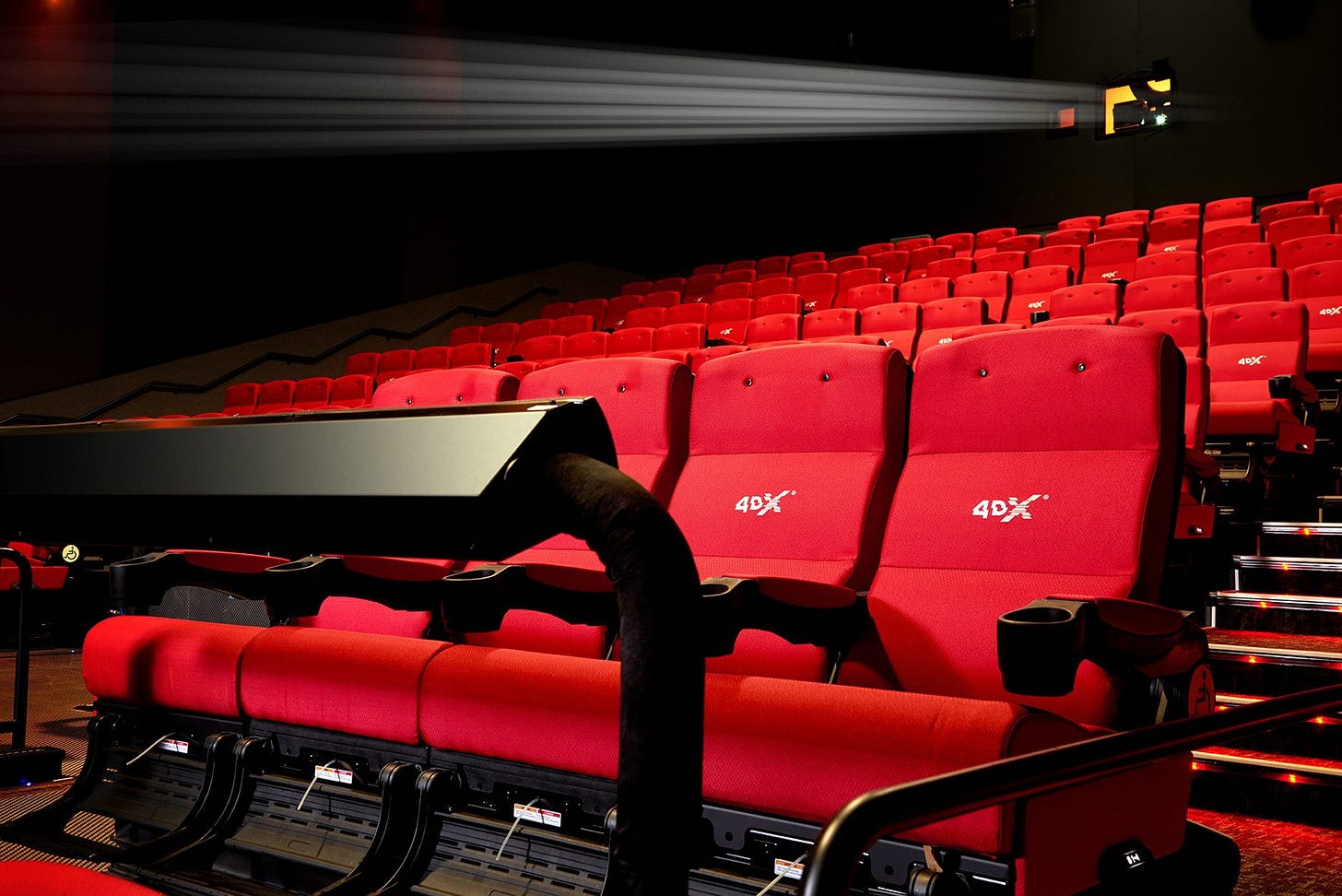
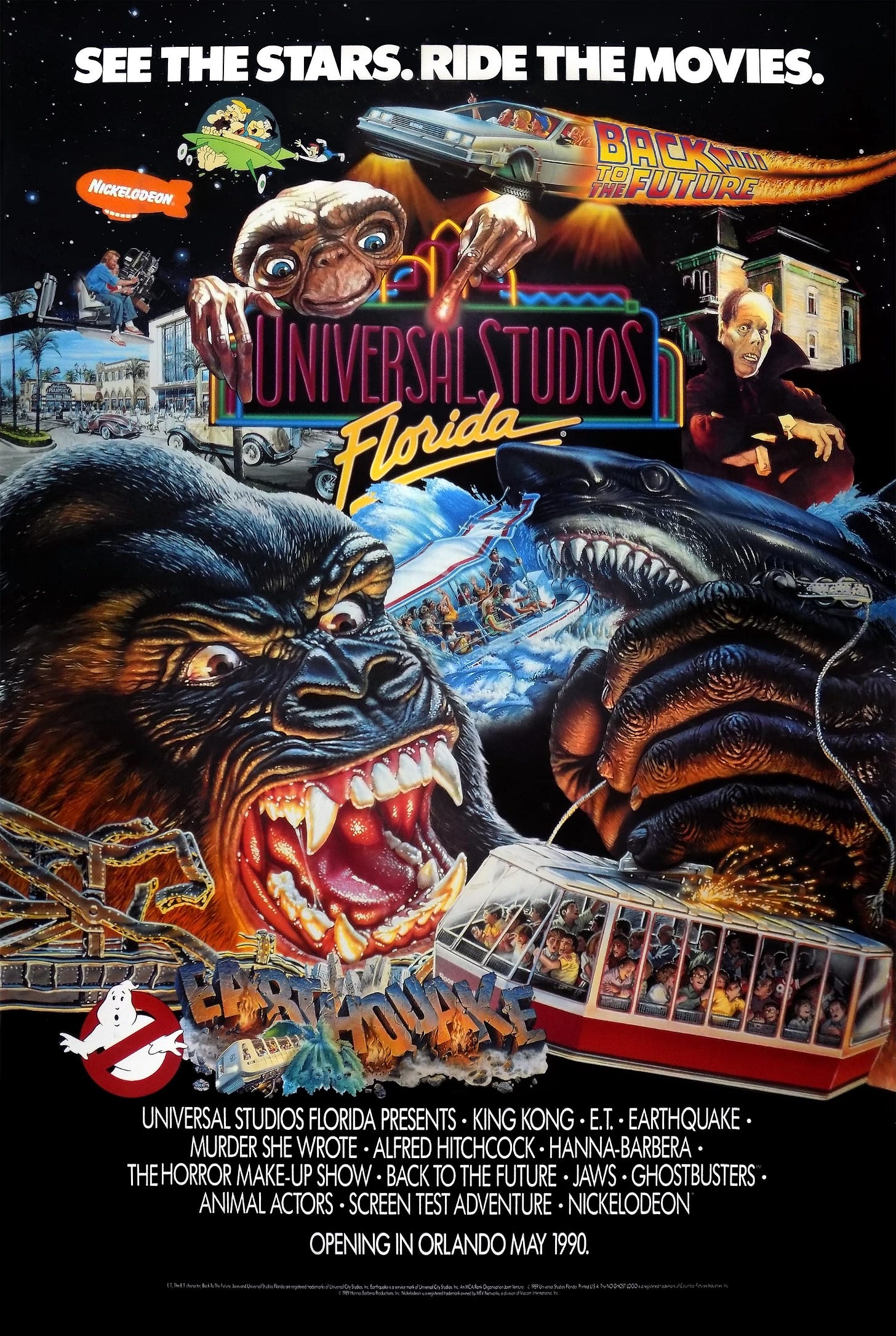
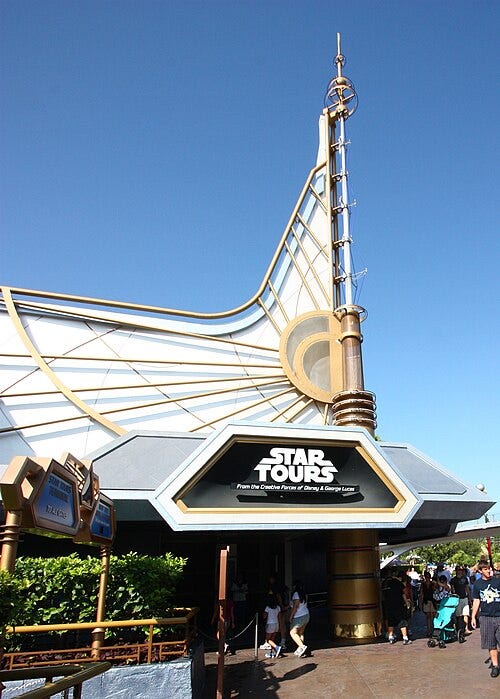

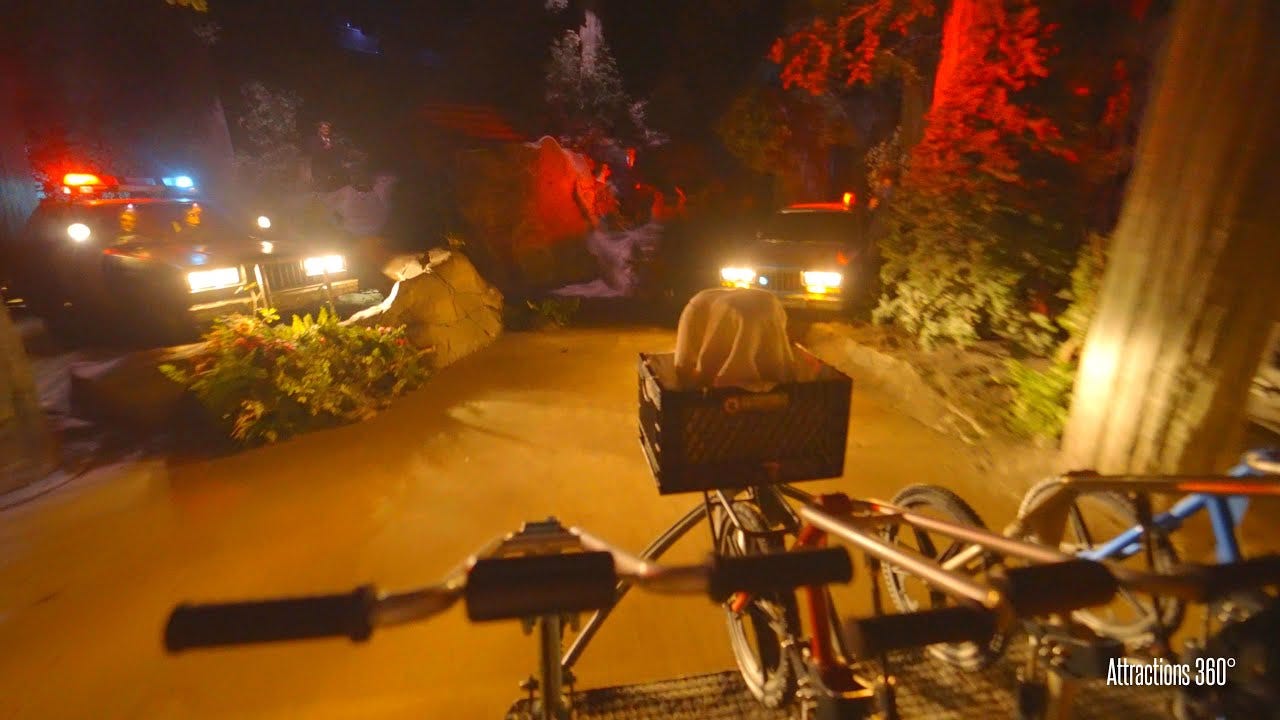
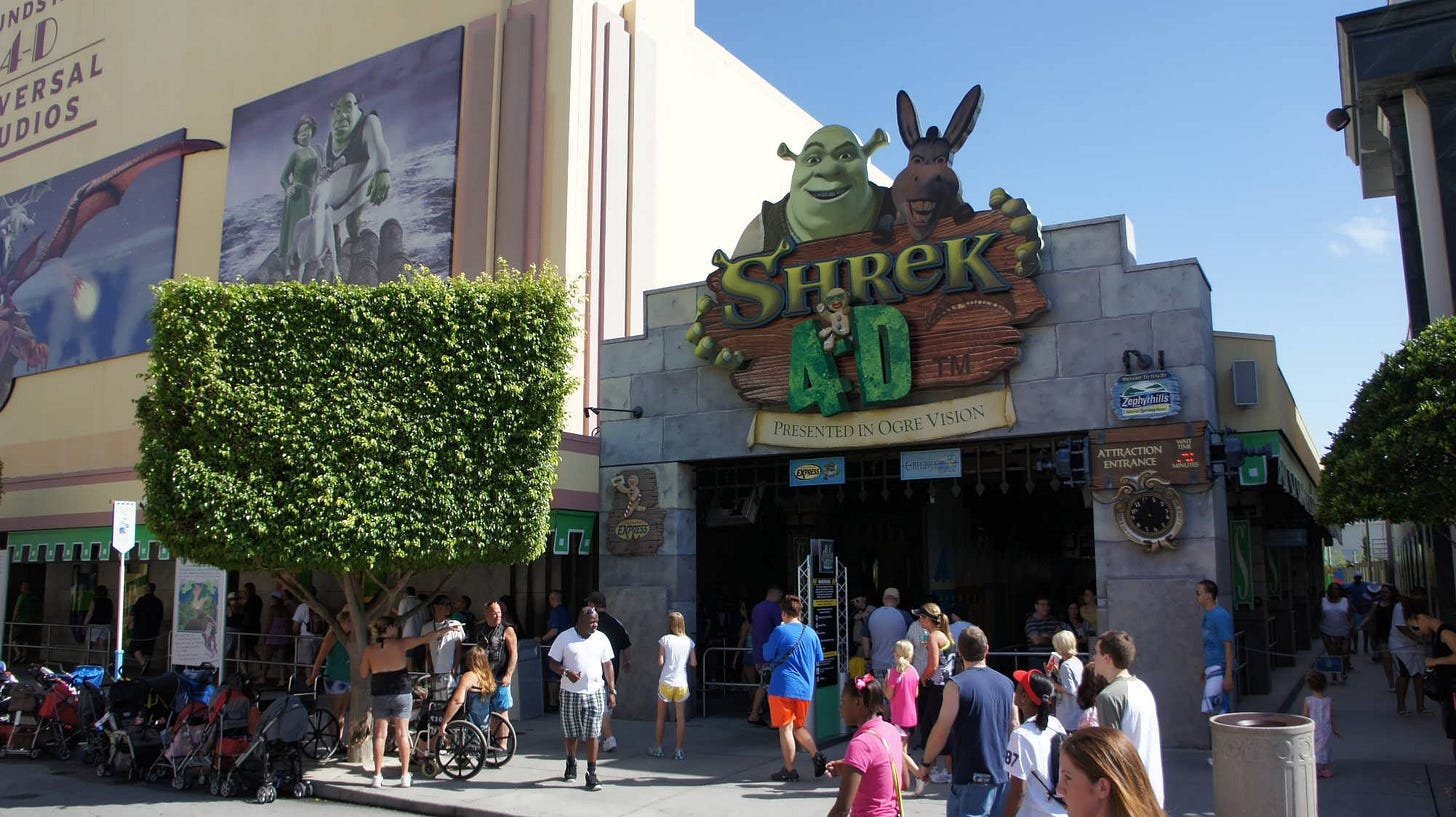
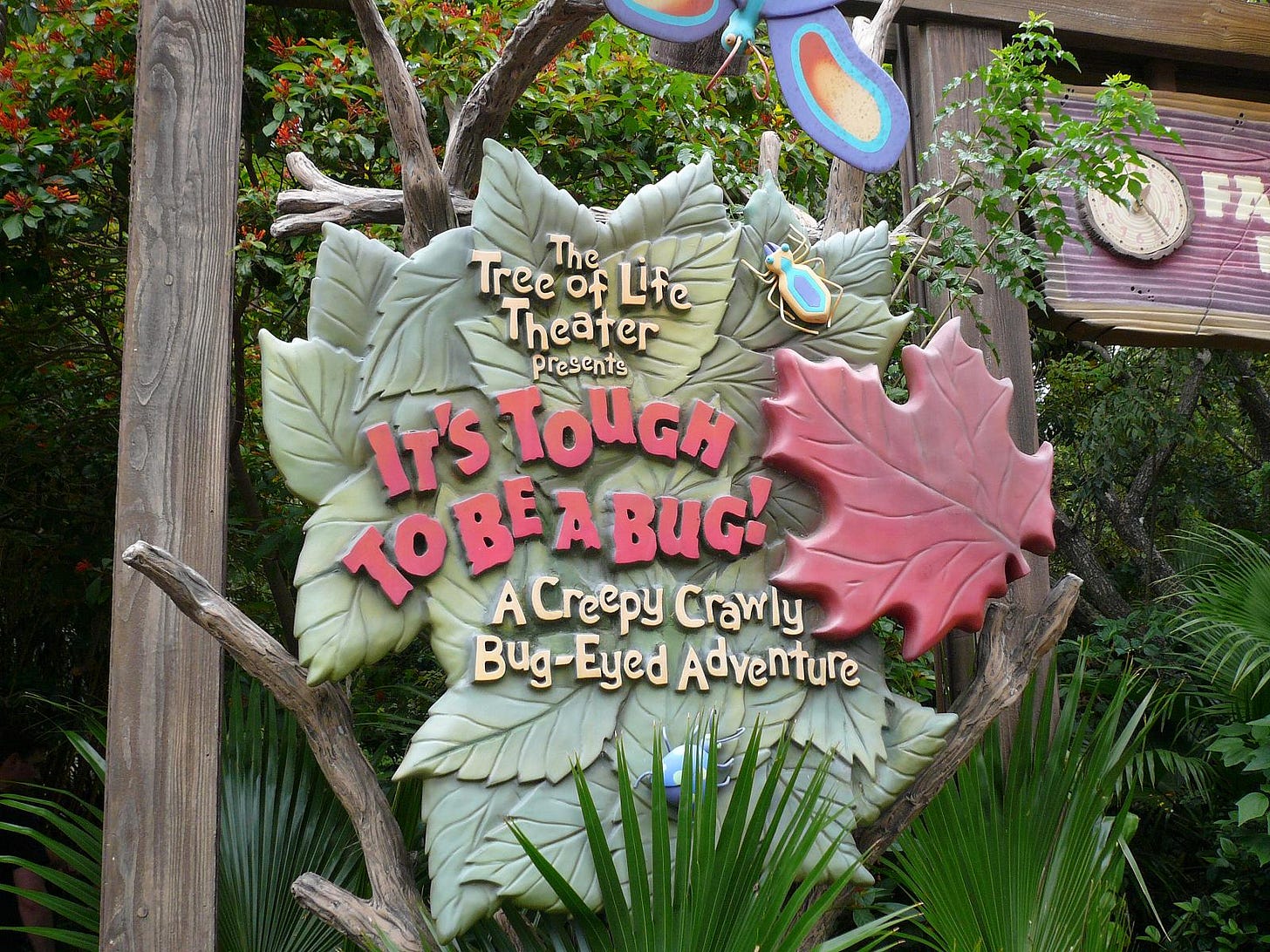
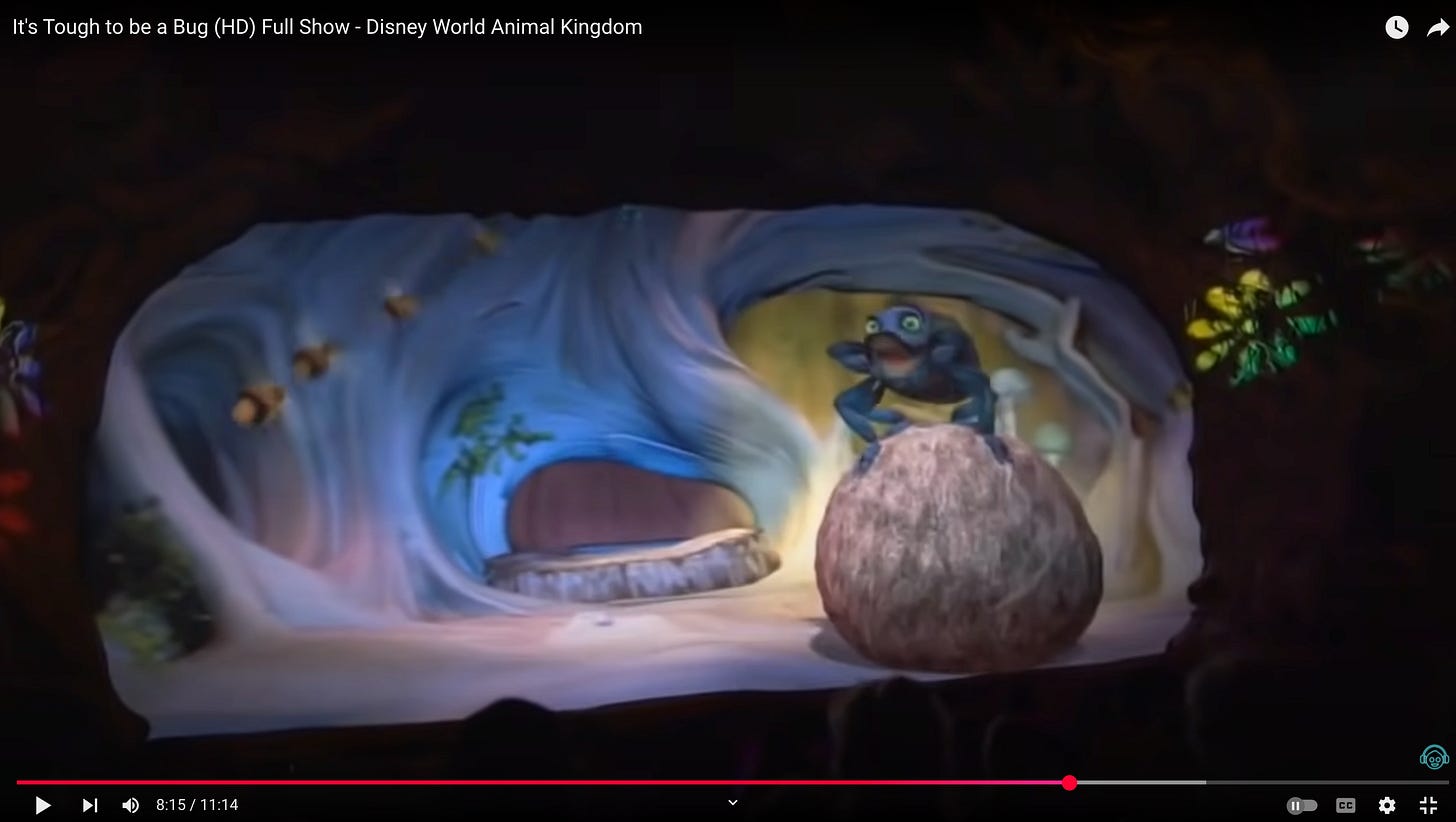

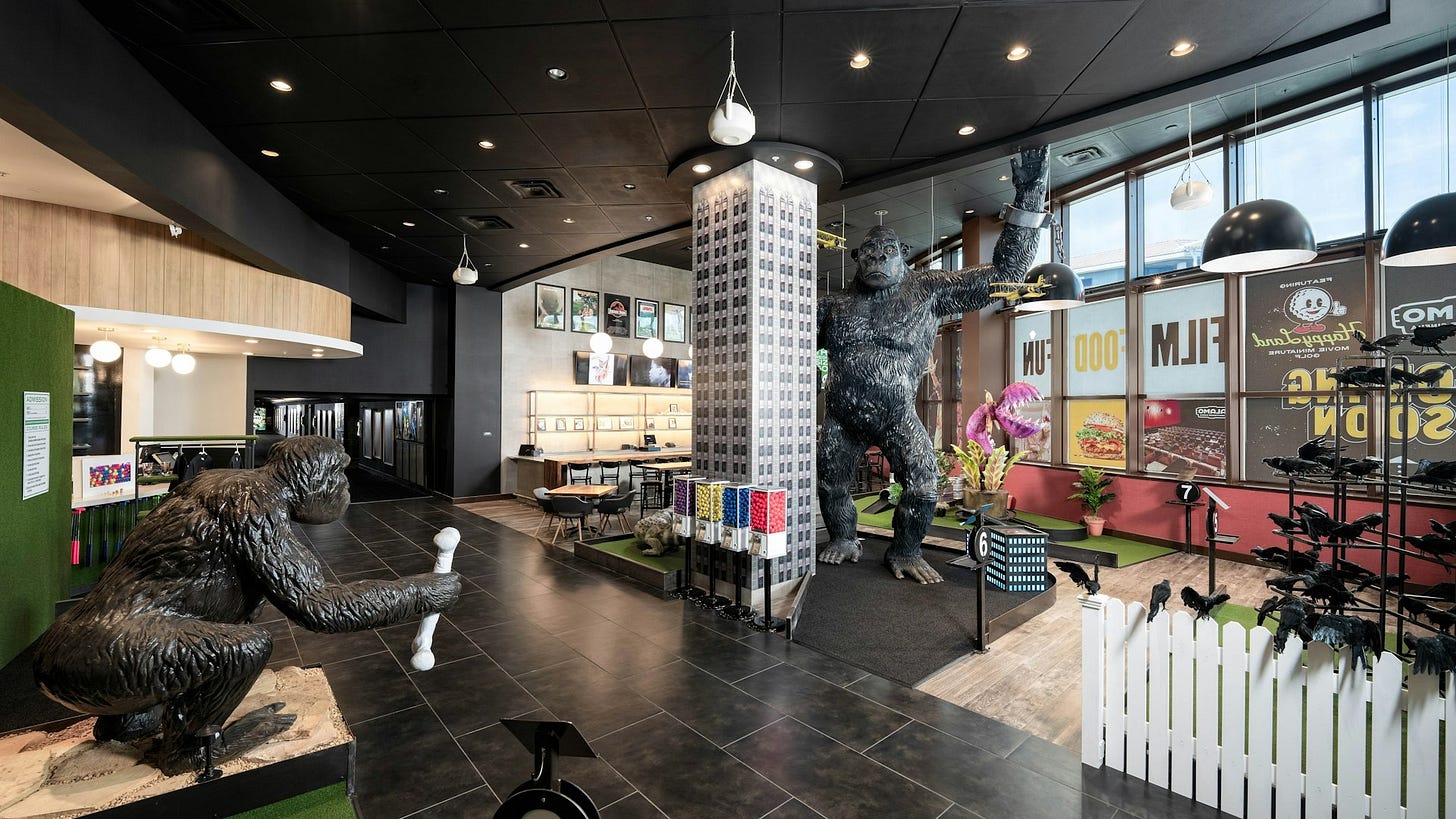

I will fly you out to our next game as an honorary alumni- we can hit up chapel hill after...